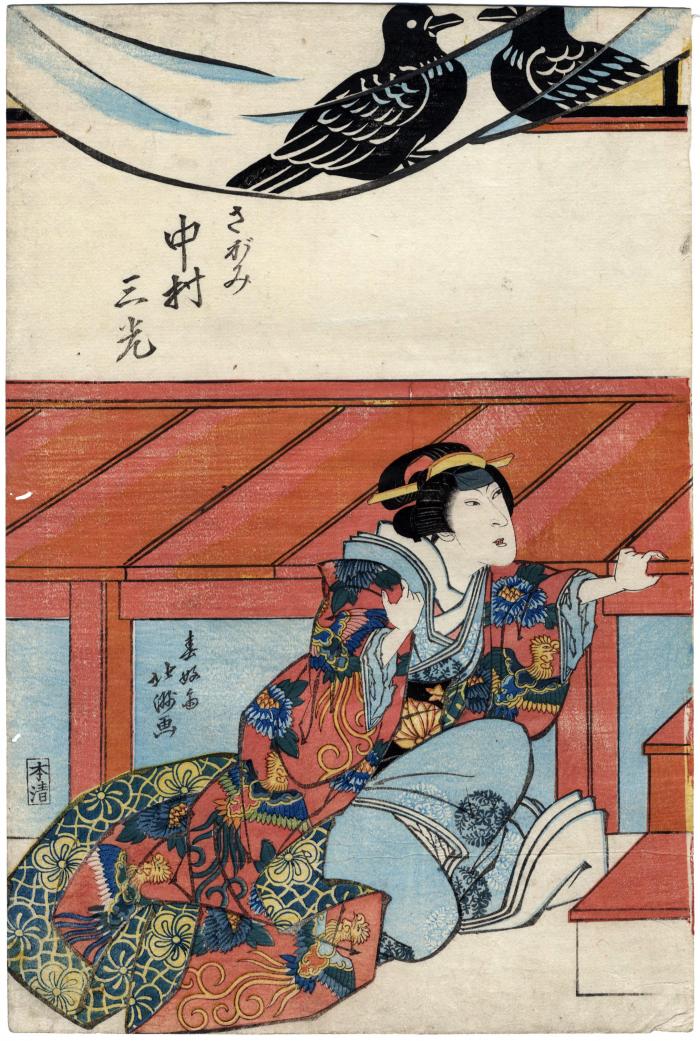Shunkōsai Hokushū (春好斎北洲) (artist ca 1808 – 1832)
Nakamura Sankō I (中村三光) as Sagami (さがみ) - left panel of a diptych
03/1825
10 in x 14.875 in (Overall dimensions) Japanese woodblock print
Signed: Shunkōsai Hokushū ga
春好斎北洲画
Publisher: Honya Seishichi (Marks 123 - seal 25-527)
Museum of Fine Arts, Boston - the complete diptych
Waseda University
The National Museum of Asian Art - full diptych
Japan Arts Council - full diptych
Another related and similar print in the Lyon Collection
Hankyu Culture Foundation
Lyon Collection - another representation of this diptych by Kunisada
Victoria and Albert Museum
Lyon Collection - an 1841 Kunisada diptych variation on this scene The print in the Lyon Collection is the left panel of a diptych. Created to commemorate a performance of the play Ichinotani Futaba Gunki (一谷嫩軍記) at the Kado Theater in Osaka in the 3rd month of 1825.
This play is based on the Tale of Heiki. Kumagae Jirō, the fellow seen on the right below, is the most important figure.
This scene is most likely from Act II. But first a little background: "Seventeen years before the play opens, Fuji no Kata, a lady-in-waiting to the Emperor, had among her ladies one named Sagami. Sagami fell in love with a warrior of the proscribed Genji faction, Kumagai Jiro Naozane. For a lady of the court to take a lover was an offence punishable by death, or at best exile, and Kumagai was, moreover, of the enemy clan. Sagami was already with child, and her plight was desperate, but her mistress took pity on her. With the help of Fuji no Kata the pair were able to fly to Western Japan. They vowed eternal gratitude to her."
Quoted from: The Kabuki Handbook by Aubrey S. and Giovanna M. Halford, p. 84.
Another thing to note is the iconography of this scene. The two facing birds are the personal crest of Kumagai. Ruth Shaver wrote in Kabuki Costume: "Kumagai, in Ichino Futaba Gunki, appears in a costume displaying the mukaibato (mukai, facing; hato, pigeon), a crest that shows two stylized pigeons facing each other. The symbolism here is of interest, for the pigeon was believed to be the messenger of the war god Hachiman, and the stylized pigeons in the crest are made to resemble the ideograph hachi, the first component of the war god's name."
In this Hokushu diptych the facing pigeons appear on the curtain and not on Kumagai's clothing. Mukaibato is 向い鳩; hachi is 八.
****
The history of a motif?
Motifs are often used not only to identify a theme, but to locate it in time. We know, for example, that the use of the facing bird motif is an identifier for presence of Kumagai. And, we know, that this play was originally composed for the puppet theater and debuted in 1751. What we don't know if when this motif of facing birds was first used for an audience.
In a brief search through various institutional collections we found numerous examples of where this motif was used on ukiyo woodblock prints. However, what surprised us was the fact that is print in the Lyon Collection is, as best we can tell, the earliest example of this motif. All of the examples we could find post-date this one. Therefore, we might postulate, that this is the first time this imagery entered our visual vocabulary.
****
Note: There must be at least two different editions of this diptych, because on some copies of the left-hand panel it is printed with the name Nakamura Sankō I (中村三光), while in others it is printed as Nakamura Matsue III (中村松江). They are two different names used by the same actor at different stages in his career.
****
Illustrated in color in Osaka Prints by Dean Schwaab, Rizzoli, 1989, page 109, #79. Schwaab wrote: "The third play of the series of the 'farewell' production [of Utaemon III] revolves around the role of Kumagai, regarded as one of the great aragoto kabuki roles... The role was in fact given the definitive performance by Utaemon II; and a Baigyoku-kata, or Utaemon mode, was later further developed by other great aragoto actors, such as Ichikawa Danjūrō VII. The scene shown here is one of the famous moments in the play, wherein the actor holds Kumagai's mie, or fixed ferocious facial expression with crossed eyes, while holding a signboard."
Honya Seishichi (本屋清七) (publisher)
actor prints (yakusha-e - 役者絵) (genre)
Nakamura Sankō I (初代中村三光: 11/1812 to 10/1813) (actor)
Ichinotani Futaba Gunki (一の谷嫩軍記) (kabuki)
Kumagai Jirō Naozane (熊谷直実) (role)
